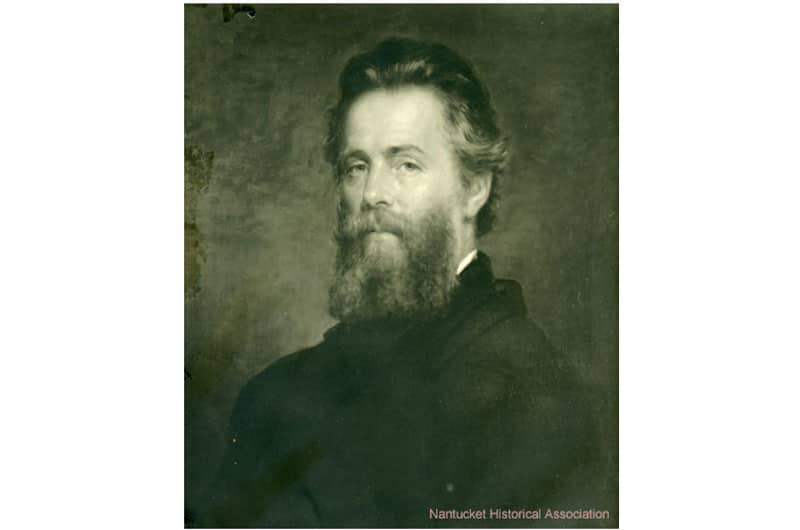~ by Amy Jenness ~
author of On This Day in Nantucket History, available at Mitchell’s Book Corner.
A year after publishing his novel Moby-Dick, Herman Melville visited Nantucket for the first, and only, time on July 6, 1852. Melville travelled with his father-in-law Massachusetts Chief Justice Lemuel Shaw. During their two day visit, the pair stayed at the Ocean House (now the Jared Coffin House), met with Thomas Macy, son of historian Obed Macy, William and Maria Mitchell, and Essex survivor Captain George Pollard.
While writing Moby-Dick in 1850 Melville began the book by making the Pequod’s first stop Nantucket. Even though he had never been here, he devoted a chapter to the island and titled it “Nantucket.” In it he famously describes the island: “Nantucket! Take out your map and look at it. See what a real corner of the world it occupies; how it stands there, away off shore, more lonely than the Eddystone lighthouse. Look at it—a mere hillock, and elbow of sand; all beach, without a background.”
Born in 1819 to a genteel family fighting to hang onto its resources and prestige, Melville began working on ships as a young man and set out on a whaling voyage from New Bedford in 1841. While whaling in the South Pacific, Melville deserted the ship Acushnet in the Marquesas Islands. He lived for three weeks with the local Typee people. After that he signed onto other whaling vessels, participating in a mutiny on one, being jailed for a time on an island and eventually landing in Hawaii and signing on to a US Naval frigate bound for Boston.
These experiences awakened Melville as a writer and in short order he wrote two best selling novels that drew heavily from his life at sea, but also mixed in scientific information and social commentary on the South Pacific – a style he would repeat in Moby-Dick. His first book, Typee, published in 1845, was an instant bestseller. Omoo was published as a sequel in 1847.
Melville married Elizabeth Shaw in 1847, and they eventually settled in western Massachusetts in the Berkshires near Nathaniel Hawthorne, who would be a close friend for a time. Melville wrote three more books that were not successful, although White Jacket; Or, the World In A Man-Of-War (1850), a searing indictment of practices aboard US Naval vessels, caused the US Congress to ban flogging on Navy ships.
In 1850 Melville began to write Moby-Dick. He returned to the familiar territory of his sea adventure stories and drew on his experiences and on the story of the Nantucket whaleship Essex.
While on board the Acushnet in 1841 Melville met Nantucket whaler William Henry Chase when their ships met up at sea, a practice known as a gam. Melville knew the sensational story of the Essex, which was rammed and sunk by an enraged sperm whale in the South Pacific in 1820. The crew drifted for 95 days in open whaleboats, running out of water and food. A gruesome story of survival and cannibalism followed the eight, who lived to go home to Nantucket. Chase’s father, Owen Chase, was one of them and wrote down his account of the story. His son William gave Melville a copy and he was transfixed. “The reading of this wondrous story upon the landless sea, & close to the very latitude of the shipwreck had a surprising effect upon me,” Melville said later.
In addition to the Essex story, Melville also studied Obed Macy’s book The History of Nantucket (1835) and used it to help describe and understand a place he had never been. Now beloved and admired as a classic American novel, Moby-Dick was virtually ignored by critics and consumers when it came out in 1851. Melville wrote two more novels before giving up fiction and turning to poetry. To support his family Melville farmed, wrote for magazines, and later worked as a customs inspector in New York City for 20 years. He published one book of poetry, which also went unnoticed.
When he died in 1891, Herman Melville was virtually forgotten as a writer. It wasn’t until the 1920s that other writers lauded Moby-Dick and Melville and made the book a popular success.
His 1852 visit to Nantucket inspired Melville to write a poem about famous island astronomer Maria Mitchell called “After The Pleasure Party” and the poem “Clarel,” about Essex captain George Pollard. Pollard would captain a Nantucket whaleship one more time after surviving the wreck of the Essex. In 1823 the Two Brothers shipwrecked on a reef and sank near the islands of Hawaii. Pollard returned to Nantucket, where he worked on a merchant vessel for a time and then worked as the island’s night watchman.
Melville recalled meeting Captain Pollard, saying, “I—sometime about 1850–53—saw Capt. Pollard on the island of Nantucket, and exchanged some words with him. To the islanders he was a nobody—to me, the most impressive man, tho’ wholly unassuming, even humble—that I ever encountered.”
The meeting left a deep impression on Melville, and in 1856, he wrote about the captain in his poem “Clarel”:
Never he smiled;
Call him, and he would come; not sour
In spirit, but meek and reconciled:
Patient he was, he none withstood;
Oft on some secret thing would brood.

